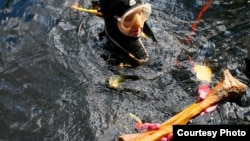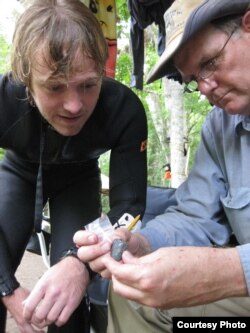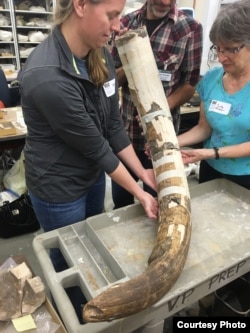A new trove of carbon-dated archaeological evidence from a submerged site in Florida has some big implications for the history of human beings in the Americas.
Researchers from several U.S. universities say their work suggests humans were wandering around Florida about 1,000 years earlier than previously thought.
Their study, published in the journal Science Advances, also paints a fascinating picture of what life in the Americas was like over 14,000 years ago.
The new evidence comes from an underwater archaeological site called Page-Ladsen that has been giving up human and animal artifacts for over 50 years.
WATCH: Underwater excavation of the Page-Ladsen site
Previous carbon dating of the objects brought up from murky waters put them anywhere between 11,000 and 13,000 years old.
But a team that dived back into the site came up with some new artifacts that date to a much earlier time — 14,550 years ago. That makes it one of the oldest sites in the Southeast, and the oldest submerged site in the Americas.
And it pushes back current thinking on when humans were in this area by well over 1,000 years.
These people were there well before the Clovis hunters, a prehistoric Paleo-Indian culture that was previously thought to be the most ancient human group living in North America.
There has always been tantalizing archaeological and genetic evidence that humans had been in the region earlier than thought, but until now it could not be proven because so few older remains had been uncovered.
In a teleconference, the scientists suggested that changing sea levels might be the reason more evidence of these ancient Americans hadn't been found.
Jessi Halligan, one of the researchers from Florida State University, said during the call that sea levels 14,000 years ago were 100 meters lower than they are today because of extensive glaciering.
That means much of the earliest record of human habitation of the American Southeast is likely buried and underwater.
The researchers' evidence is contained in stone tools and mastodon bones brought up from the 8-meter-deep sinkhole in the Aucilla River in Florida.
They said the tools were clearly used to butcher the mastodon alongside a watering hole that, 15,000 years ago, would have been 200 kilometers from the shoreline. Today, it is the coastline.
As further evidence that this population was a separate culture from the Clovis people, the researchers in their teleconference pointed to distinct differences between the stone tools they recovered and the flaked points of Clovis culture tools.
In addition to pushing back the frontier of human colonization of the Americas, the evidence also paints a picture of a much different world.
Fourteen thousand years ago, camels, mastodons and giant armadillo-like animals called Glyptodons, to name a few, lived in the area in abundance, but went extinct 10,000 to 11,000 years ago.
Another tantalizing discovery are bones the researchers believe are from dogs, which even back then are likely to have been trained companions.
The humans and their faithful friends, resilient as always, stayed, survived and thrived.
















